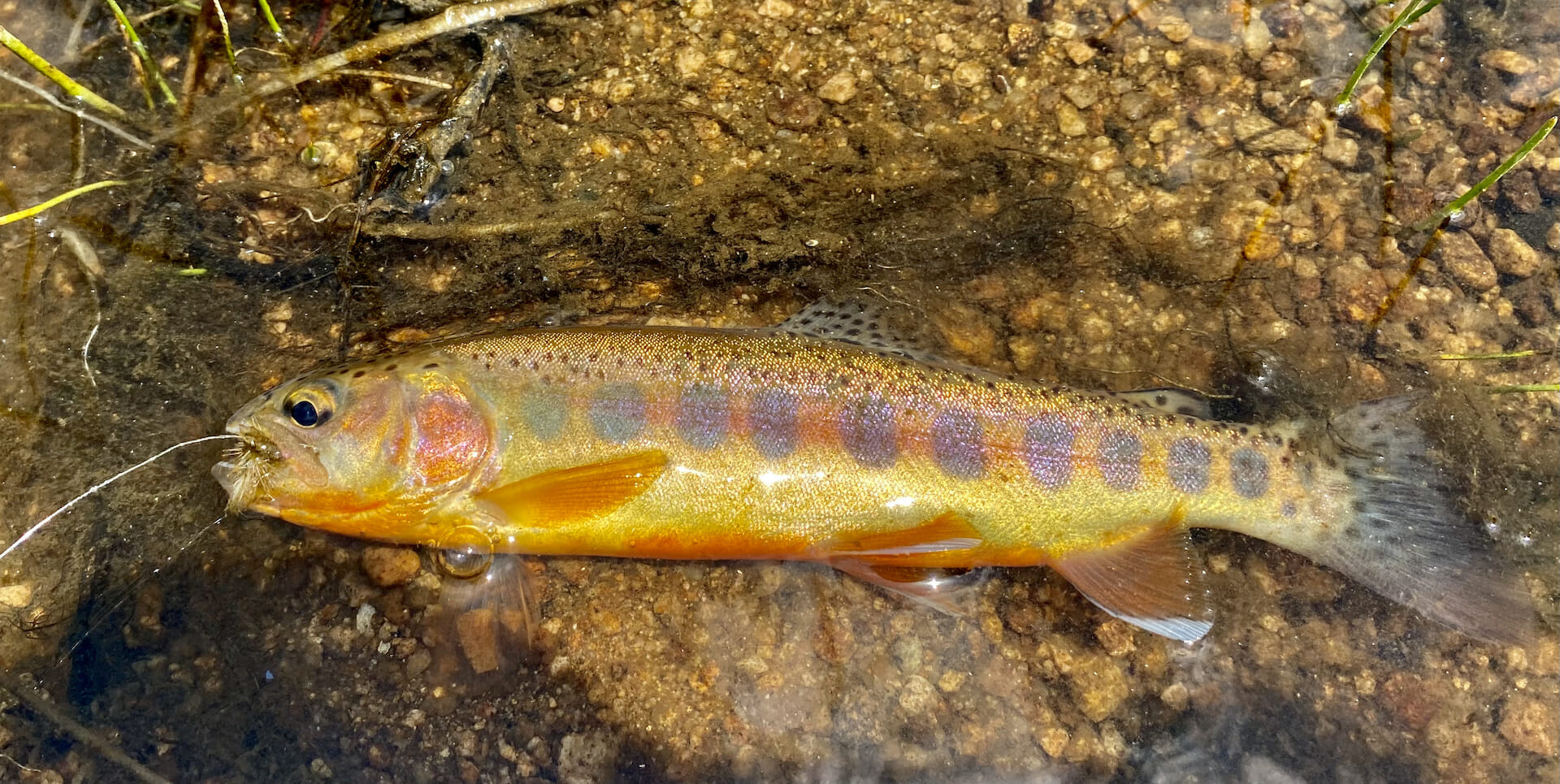California golden trout (Oncorhynchus mykiss aguabonita)
Species summary and status: The state fish of California, California golden trout once occupied about 450 miles of stream habitat in the upper South Fork Kern River and the adjacent Golden Trout Creek. Currently, the trout is native only to two high-altitude watersheds in California’s rugged Sierra Nevada Mountains. The California golden trout, formerly called the Volcano Creek golden trout, is one of the most colorful trout in the world.
Coloration is spectacularly bright: the belly, opercula, lower jaws, and lateral line are a vivid red to red-orange. The back is a deep olive-green, fading to bright gold on the sides of the fish. About 10 parr marks are centered on the lateral line and are usually present through adulthood. Body spots are large, round, dark, and concentrated near the caudal peduncle and on the dorsal and caudal fins. Spots are not usually present below the lateral line. Paired fins are orange, and some have white or yellow tips preceded by a black band. Dorsal fin also with a white to orange tip.
The historic range of California golden trout includes two watersheds draining the Kern Plateau of the southern Sierra Nevada Mountain Range in California. Golden trout are native to Golden Trout Creek (GTC) and the South Fork of the Kern River (SFKR), an area encompassing approximately 593 square miles. They historically occupied GTC from the headwaters, with the possible exception of the upper reaches of some tributary streams and headwater lakes, downstream to a series of waterfalls near the mouth. In the SFKR, CGT were present from the headwaters downstream at least to the southern end of the present-day Dome Land Wilderness and perhaps downstream of Lake Isabella. They may also be found in several populations outside of their original range established from transplants from GTC about 100 years ago. Many populations outside the original range are established from stocking hatchery produced fingerlings from the Cottonwood Lakes brood stock, which were discovered in the 1990’s to be hybridized with rainbow trout. These are found primarily in the Sierra Nevada between Yosemite and Sequoia/Kings Canyon National Parks.
Looking forward: It is recognized now, by far the greatest threat to the continued existence of CGT is from hybridization and introgression with non-native rainbow trout. CGT readily hybridizes with other subspecies of rainbow and cutthroat trout. Hybridization with close relatives such as rainbow trout dilutes the fundamental genetic character of California golden trout, resulting in a significant loss to the native gene pool over time.
Due to the remoteness of most of the Kern Plateau, a diversity of land uses is limited. The use with the highest impact and that which has caused most of the habitat degradation is grazing of domestic livestock. There are four major grazing allotments that have historically impacted meadow and riparian habitat. It is important to note that these grazing impacts affect most meadow and riparian dependent species, not just fish. The impacts of grazing to California golden trout habitats include the loss of pool habitat, sedimentation, reduced instream cover, riparian cover loss, loss of undercut streambanks, stream channels becoming wider and shallower, the resultant inability of the system to buffer temperature extremes (increased summer water temperatures and threat of icing in colder months), loss of quality spawning habitat and reduction of instream and riparian area food production. Riparian and meadow habitat degradation is common to both the SFKR and GTC watersheds in many areas where cattle-grazing is permitted. Recreational use can have a similar negative impact on streambanks, but the damage is limited to a few sections of the SFKR.
Beginning in 2000, Inyo National Forest, the government agency responsible for land management on most of the Kern Plateau, decided to stop grazing for 10 years on two of the four grazing allotments. The Templeton and Whitney allotments covered most of the GTC and upper SFKR watersheds. Studies are being conducted to document the recovery of meadow and stream habitat in the absence of grazing. It is possible that cattle could be put back onto these two allotments, so the collection of physical and biological data is critical to future management decisions. This information will be useful when the other two allotments come up for NEPA review in 2008.
Since 2008, the Western Native Trout Initiative has contributed $48,000 to 2 projects benefiting California Golden Trout and Little Kern Golden Trout. Project goals were to estimate populations, analyze genetics, and trends in age, growth and size composition of the fishery as well as evaluate how changes in climate and the 2011 Lion Fire have affected trout populations.
All data compiled from:



